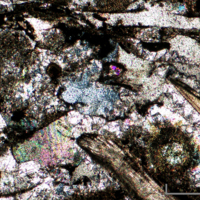- Home
- Rocks
- Type fossils
- Fossil Specimens
- Minerals
- Glossary
- Stratigraphic Chart
- Michel-Levy Chart
- Classification of igneous rocks
- University of Cambridge
- Department of Earth Sciences
- ESC Library
- Moodle
- Sedgwick Museum
- DoITPoMS
- Mindat.org
- Microfossils
- Bryozoans
- Webmineral
- Tree of Life
- CrystalMaker
- Virtual Microscope
L354 - Shelly limestone
Age
Middle Jurassic
Location
Forest Marble
Near Weymouth
Near Weymouth
Hand Specimen
This rock is made up of well cemented bioclasts. The bioclasts (mainly shell fragments) are poorly sorted, ranging from <1mm up to a few 10s of mm.
Fine-grained cement fizzes with acid, indicating that it is carbonate. It has weathered to a pale yellow-grey.
Fine-grained cement fizzes with acid, indicating that it is carbonate. It has weathered to a pale yellow-grey.
Thin-section
Carbonate fossil fragment in a carbonate cement (sparite). The laminated structure of the shells is visible in places.
Cement contains some hematite (brown regions).
There are a few epidote grains and some opaque areas.
This is a rudstone (Dunham naming system) or biosparite (Folk naming system).
Cement contains some hematite (brown regions).
There are a few epidote grains and some opaque areas.
This is a rudstone (Dunham naming system) or biosparite (Folk naming system).
Rock History
The shells are not in life position – they have been transported.
Deposited in moderate to high energy environment.
Deposited in moderate to high energy environment.
Rock Name
shelly limestone



